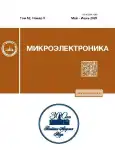Hydrogen Plasma under Conditions of Electron-Cyclotron Resonance in Microelectronics Technology
- Authors: Polushkin E.A.1,2, Nefed’ev S.V.1, Koval’chuk A.V.2, Soltanovich O.A.2, Shapoval S.Y.2
-
Affiliations:
- JSC Molecular Electronics Research Institute
- Institution of Science, Institute of Problems of Microelectronics Technology and High-Purity Materials, Russian Academy of Sciences
- Issue: Vol 52, No 3 (2023)
- Pages: 236-239
- Section: ТЕХНОЛОГИИ
- URL: https://journals.rcsi.science/0544-1269/article/view/138573
- DOI: https://doi.org/10.31857/S0544126923700321
- EDN: https://elibrary.ru/UECTWT
- ID: 138573
Cite item
Full Text
Abstract
This paper presents the results of hydrogen electron-cyclotron resonance (ECR) plasma in micro-electronics technology. Its effect on the radiation resistance of the IC and on the quality of the ohmic contact during the formation of UBM metallization is demonstrated. The devices obtained with the use of plasma ECR and without it are analyzed.
Keywords
About the authors
E. A. Polushkin
JSC Molecular Electronics Research Institute; Institution of Science, Institute of Problems of Microelectronics Technology and High-Purity Materials, Russian Academy of Sciences
Email: epolushkin@niime.ru
Moscow, Zelenograd, 124460 Russia; Chernogolovka, Moscow oblast, 142432 Russia
S. V. Nefed’ev
JSC Molecular Electronics Research Institute
Email: epolushkin@niime.ru
Moscow, Zelenograd, 124460 Russia
A. V. Koval’chuk
Institution of Science, Institute of Problems of Microelectronics Technology and High-Purity Materials, Russian Academy of Sciences
Email: epolushkin@niime.ru
Chernogolovka, Moscow oblast, 142432 Russia
O. A. Soltanovich
Institution of Science, Institute of Problems of Microelectronics Technology and High-Purity Materials, Russian Academy of Sciences
Email: epolushkin@niime.ru
Chernogolovka, Moscow oblast, 142432 Russia
S. Yu. Shapoval
Institution of Science, Institute of Problems of Microelectronics Technology and High-Purity Materials, Russian Academy of Sciences
Author for correspondence.
Email: epolushkin@niime.ru
Chernogolovka, Moscow oblast, 142432 Russia
References
- Herring C. Energy levels of isolated interstitial h-ydrogen in silicon / C. Herring, N.M. Johnson, C.G. Van De Walle // Physical Review B: Condensed Matter and Materials Physics. 2001. V. 64. № 12. P. 1252091–12520927. EDN XOOMMJhttps://doi.org/10.1103/physrevb.64.125209
- Influence of diffusion hydrogen on the radiation hardness of silicon devices / E.A. Polushkin, A.V. Kovalchuk, O.A. Soltanovich [et al.] // Proceedings of SPIE V. 12157, International Conference on Micro- and Nano-Electronics 2021, 1215711 (2022). EDN MBGAEWhttps://doi.org/10.1117/12.2624184
- Гольцов В.А. Фундаментальные основы водородной обработки материалов / В.А. Гольцов // Письма в международный научный журнал “Альтернативная энергетика и экология”. 2014. № 2(2). С. 31–33. EDN RYPZWV.
- Popov O.A. 2.45 GHz microwave plasmas at magnetic fields below ECR / O.A. Popov, S.Y. Shapoval, M.D. Yoder // Plasma Sources Science and Technology. 1992. V. 1. № 1. P. 7–12. EDN VECNSXhttps://doi.org/10.1088/0963-0252/1/1/002
- Темирбулатов М.С. Космическая программа и радиационная стойкость современных интегральных микросхем / М.С. Темирбулатов, В.И. Эннс // Электронная техника. Серия 3: Микроэлектроника. 2015. № 2(158). С. 76–88..
- Змеев С.В. Коммутация кристаллов припойными шариками в микросистемах 2,5D- и 3D-сборок / С.В. Змеев // Наноиндустрия. 2020. № S96-2. С. 434–437. EDN UKVTNKhttps://doi.org/10.22184/1993-8578.2020.13.3s.434.437
Supplementary files













